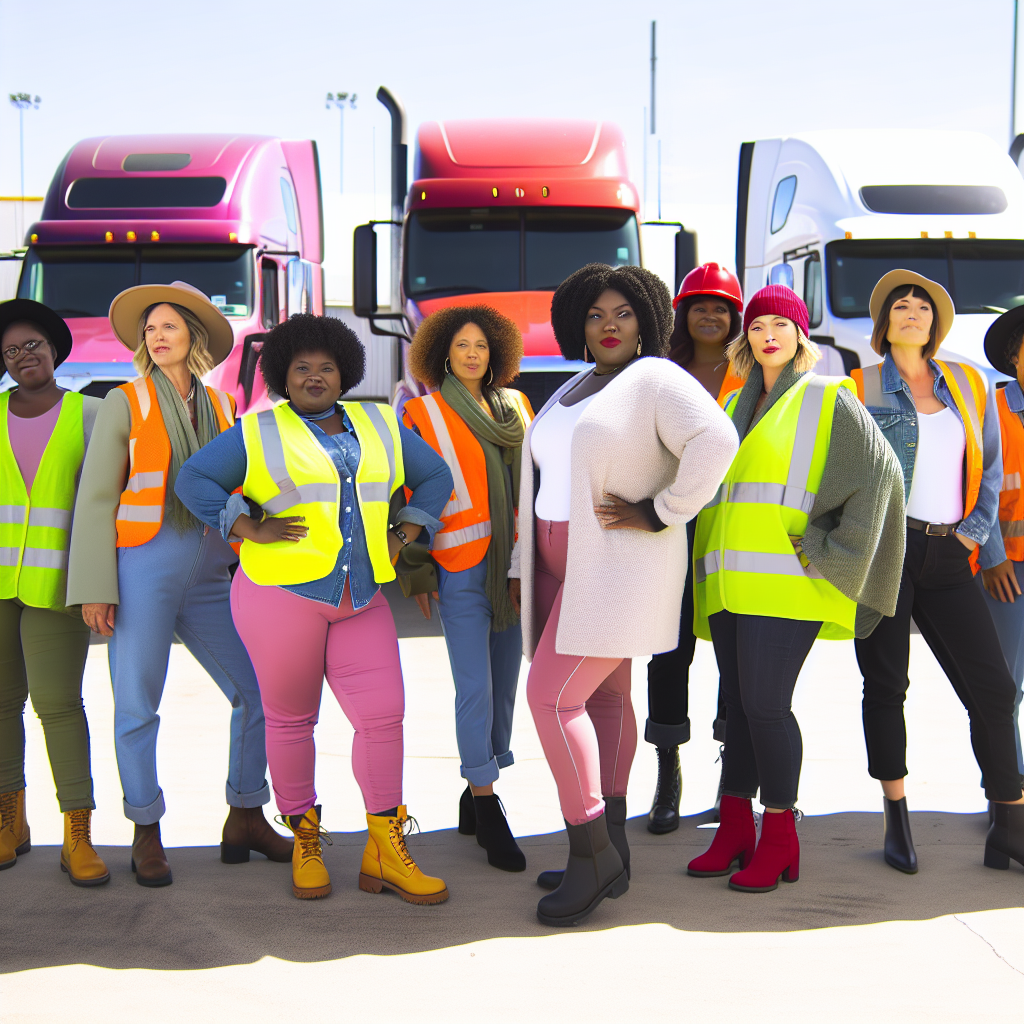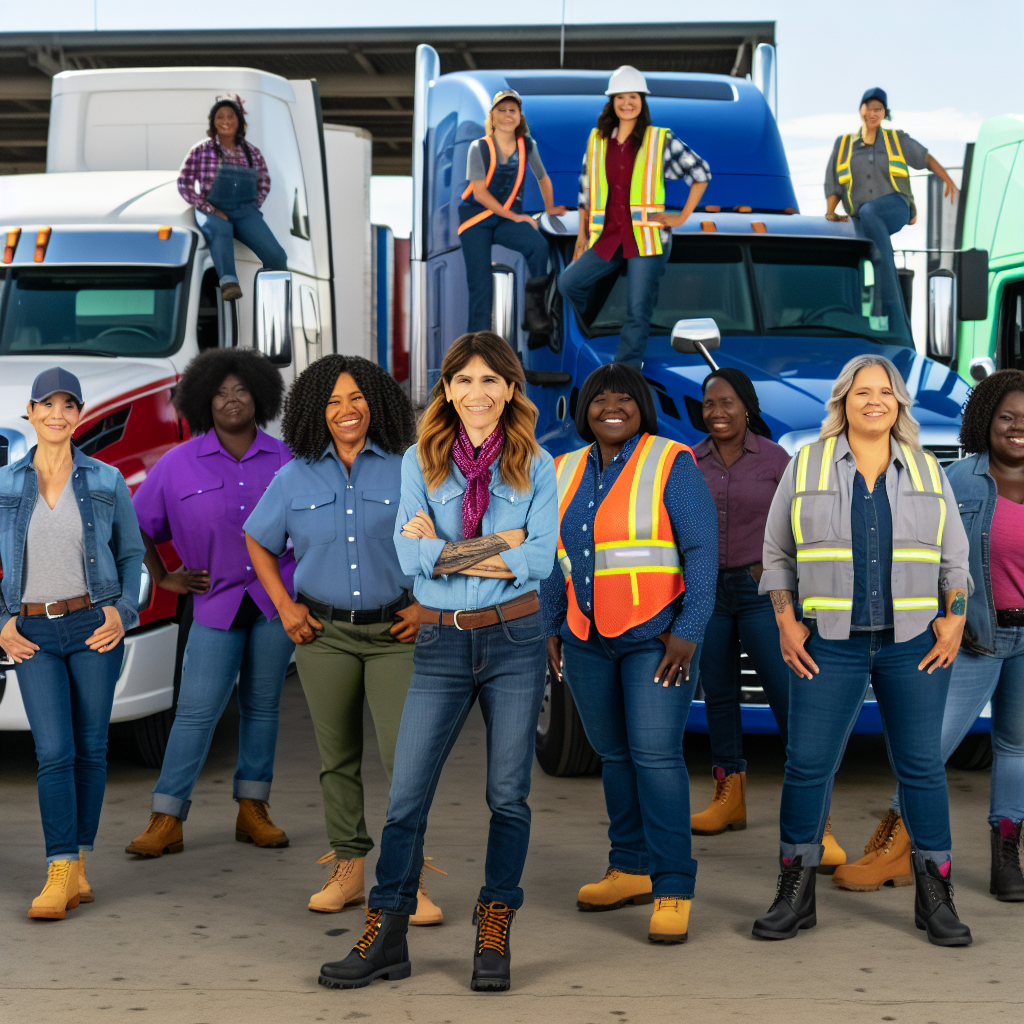In the trucking industry, women face a unique set of challenges that often impede their progress and success. From navigating systemic barriers such as harassment to seeking advancement in a predominantly male-dominated field, they continue to demonstrate remarkable resilience. Women are not just surviving in this industry; they are advocating for meaningful systemic changes that can pave the way for future generations. Their calls for support and representation underscore a collective strive to create a more inclusive environment where equal opportunities flourish. By sharing their experiences, these women stand united, inspiring others to join the cause. Each voice contributes to a symphony of change, emphasizing the critical need for allyship and mentorship. As they break through the glass ceiling, they exemplify not only the power of perseverance but also the transformative importance of pulling together as a community.
As Kelly Cooper famously stated, “Don’t let the assholes win.” This quote reinforces the spirit of resilience among women in trucking, serving as a rallying cry for those fighting against adversity in the face of systemic challenges. In this ongoing battle for equity, female truckers are pushing beyond the current limits, reminding us all that their fight is not merely for personal gain but for a more just industry for everyone.
Barriers Faced by Women in the Trucking Industry
Women in the trucking industry face many systemic barriers that hinder their ability to thrive. These challenges are deeply rooted in the male-dominated culture of the industry. Issues like harassment and obstacles in career growth often leave women feeling marginalized and unsupported.
One major barrier is sexual harassment, which is still common in the trucking world. A survey by the Women in Trucking Association showed that nearly 50 percent of female drivers experienced some form of harassment. This toxic work environment affects women’s mental health. It also discourages them from pursuing careers in trucking. For instance, truck driver Stephanie Carruth spoke about the harassment she faced. She described it as a significant reason for considering leaving the industry. This shows how harassment can discourage talented women from succeeding in their careers.
Additionally, women encounter significant obstacles when advancing in their careers. Many trucking companies have rigid hierarchies. In such environments, networking and informal mentorship often favor male employees. Kelly Cooper pointed out that women struggle to find mentors who can help guide them. When women are overlooked for leadership roles, it perpetuates gender inequality. It also stifles diverse perspectives needed for better decision-making in companies.
Moreover, the lack of representation at executive levels makes it difficult for women to see a clear path for advancement. Colleen Leonard noted that without female leaders, the potential for mentorship and allyship in the workplace diminishes. This leads to a cycle of inadequate support for new female professionals.
These systemic barriers heavily impact female retention in the trucking industry. Without change, the industry risks losing talented women seeking more equitable and supportive work environments. To create a more inclusive atmosphere, it is essential for industry leaders to recognize these barriers. They must implement policies that address the unique challenges women face. Only then can the trucking sector fully benefit from the diverse talents and perspectives of all its workers.
| Statistic | Trucking Industry | Overall Industry |
|---|---|---|
| Percentage of Women Drivers | 9.5% | 47.1% |
| Percentage of C-suite Executives | 31.6% | 15% |
| Percentage of Leadership Roles | 36.9% | 28% (across various sectors) |
| Reported Harassment Incidents | 40% of women report harassment | 25% (average across all industries) |
The data above reflects the current challenges faced by women in the trucking industry compared to the overall workforce. The stark contrast in metrics underlines the need for continued advocacy and systemic change to create a more inclusive environment. Women in trucking not only represent a vital part of the workforce, but also push for leadership and equitable treatment in an industry that has much room for improvement.
Advocacy Efforts in the Trucking Industry
The trucking industry has seen a concerted effort to promote gender diversity and support women through various initiatives, advocacy efforts, and mentorship programs.
Women in Trucking Initiatives and Advocacy Efforts
The American Trucking Associations (ATA) relaunched its “Women in Motion” program in February 2024, aiming to positively impact women in the trucking industry through education, networking, and advocacy. This initiative seeks to create lasting change for future generations by addressing the unique challenges faced by women in trucking. (fleetowner.com)
Similarly, the Women In Trucking Association (WIT) focuses on encouraging the employment of women in the trucking industry, promoting their accomplishments, and minimizing obstacles they face. WIT advances its mission through scholarships, mentorship, conferences, and related programs and services. Since its founding, WIT has awarded over 350 scholarships totaling more than $350,000, helping women pursue careers as drivers, technicians, and leaders. (chrobinson.com)
Impact of Mentorship Programs in the Trucking Industry
Mentorship programs have proven instrumental in supporting women entering the trucking industry. For instance, the “LeadHERtrucking” program offers a five-month mentorship for women new to trucking. This program includes monthly virtual one-on-one meetings between mentors and mentees, as well as virtual sessions covering various topics facilitated by industry experts. The goal is to provide substantive content that connects participants and addresses the challenges and stages of professional driving. (leadheralliance.com)
Additionally, the Women In Trucking Association provides “WIT Connections,” an online networking and career development tool that helps members share experiences and build relationships. This platform allows for one-on-one mentorships and the formation of networking groups, fostering a supportive community for women in the industry. (engage.womenintrucking.org)
GFL and Women in Waste Program
GFL Environmental Inc. has demonstrated a commitment to increasing the participation of women across its operations through the “Women in Waste” (WIW) program. This initiative includes a corporate women’s leaders’ group and a virtual support network for women in field operations. GFL’s efforts have been recognized, as the company was named one of the top companies for women to work for in transportation in 2023 by the Women In Trucking Association. (gflenv.com)
Contributions of Women in Trucking to Systemic Change
Organizations like the Real Women in Trucking (RWIT) are committed to supporting women in the industry through advocacy efforts. RWIT’s mission is to deliver highway safety through leadership, mentorship, education, and advocacy, aiming to improve the work and lifestyle environment for all drivers. (realwomenintrucking.org)
Furthermore, the African American Women Trucking Association (AAWTA) launched “The Power to Drive Change” initiative, a fundraising gala celebrating the achievements of African American women in the trucking industry. This program seeks to address barriers and create opportunities for advancement through mentorship and development programs. (aawta.org)
These collective efforts contribute to systemic change by fostering a more inclusive and supportive environment for women in the trucking industry, addressing challenges unique to women drivers, and offering them the support of strong networks of experienced female drivers.

This image visually represents women in the trucking industry, showcasing diversity and empowerment. The women are depicted standing confidently beside trucks, emphasizing their strength and unity in a traditionally male-dominated field.
Conclusion
In conclusion, addressing systemic change within the trucking industry is not just a matter of equity; it is essential for the overall growth and sustainability of the industry. Throughout this article, we have highlighted the resilient efforts of women who strive to overcome significant barriers, such as harassment and limited career advancement opportunities. Initiatives like the Women in Trucking Association and the various mentorship programs prove critical in fostering an environment where women can thrive and contribute their talents to the industry. These advocates underscore the importance of representation and equal opportunities, emphasizing that their fight is as much about paving the way for future generations as it is about their personal journeys.
As we move forward, it is crucial to continue supporting these advocacy efforts with renewed vigor. By contributing to initiatives that promote systemic change and prioritize diversity, we can help transform the trucking industry into a more inclusive space. We encourage readers to take action—whether through advocacy, mentorship, or raising awareness—supporting women in trucking is vital to building a stronger and more equitable industry for all. Together, we can change the narrative and ensure a brighter future where everyone in trucking has the opportunity to succeed.
Summary of Women in Leadership Roles in the Trucking Industry
Recent studies and reports have offered valuable insights into the representation of women in leadership positions within the trucking industry, showcasing both advancements and ongoing challenges. The 2023 Women In Trucking (WIT) Index indicated that women occupy 36.9% of company leadership roles, 31.6% of C-suite executive positions, and 28.4% of board director seats in transportation. These statistics reflect a notable increase in female representation across various leadership levels, signaling a positive trend for gender diversity in the industry. [source]
Despite these advancements, the 2024-2025 WIT Index pointed to some setbacks. The percentage of female truck drivers fell from 12% to 9.5%, and representation of women on corporate boards decreased from 32% to 29.5%. Such declines highlight persistent challenges in fostering gender diversity within the trucking sector. [source]
Interestingly, the data revealed that smaller trucking companies tend to have higher female representation. Women make up 12.5% of drivers in small firms, compared to 10.5% in medium-sized companies and only 7% in large firms. This observation emphasizes the significant role company size plays in supporting or hindering female participation in the workforce. [source]
In terms of safety roles within the industry, women have made strides, with females now holding 41.6% of safety professional positions in transportation. This increasing presence in essential operational roles underscores the expanding opportunities for women within the trucking field. [source]
In summary, while there have been significant advancements in women’s leadership representation within the trucking industry, challenges remain, particularly in driver numbers and board positions. Continued efforts and initiatives are necessary to foster a more inclusive and supportive environment that promotes women’s advancement across all levels of the trucking sector.
Related Keywords
Enhancing your blog’s SEO with targeted keywords like ‘diversity in trucking,’ ‘mentorship in trucking,’ and ‘job shadowing’ can attract readers interested in these topics. Below are insights and definitions for each keyword, along with relevant statistics and programs:
1. Diversity in Trucking
Definition: Diversity in trucking refers to the inclusion and representation of various demographic groups within the trucking industry, encompassing differences in gender, race, ethnicity, and other characteristics.
Statistics:
- Women constitute approximately 12.1% of professional drivers in the trucking industry. Source
- Minority drivers account for about 30% of the commercial driver population in the U.S. Source
- An average of 36.9% of company leaders in the trucking industry are women. Source
Programs:
- Women In Trucking Association (WIT): Founded in 2007, WIT focuses on promoting the employment of women in the trucking industry and addressing obstacles that might keep women from entering or succeeding in the field. Source
2. Mentorship in Trucking
Definition: Mentorship in trucking involves experienced industry professionals guiding and supporting less experienced individuals to help them develop skills, navigate career paths, and integrate into the trucking community.
Statistics:
- Implementation of mentorship programs for underrepresented groups has increased driver retention by 20%. Source
Programs:
- Women In Trucking Association’s Mentorship Program: WIT offers mentorship opportunities connecting experienced female truck drivers with newcomers to provide guidance and support.
3. Job Shadowing
Definition: Job shadowing is an educational experience where an individual observes a professional in their work environment to gain insights into the daily responsibilities and skills required for a particular job.
Programs:
- Trucking Company Ride-Along Programs: Some trucking companies offer ride-along or job shadowing programs, allowing prospective drivers to experience the realities of the job firsthand.
Incorporating these keywords into your blog content, along with the associated statistics and program information, can enhance your SEO and provide valuable information to your readers.
The Importance of Representation in Leadership
Representation in leadership within the trucking industry is not just a matter of fairness; it plays a critical role in employee retention and overall organizational success. Diversity in leadership fosters a culture that values different perspectives, driving innovation and problem-solving capabilities. According to research from the Women in Trucking Association, companies with diverse leadership teams report higher levels of employee satisfaction and engagement, which are pivotal for retaining top talent.
A significant statistic highlights that workplaces with diverse representation are 35% more likely to outperform their competition in profitability. This is particularly relevant in the trucking sector, where recruiting and retaining skilled drivers is increasingly challenging due to high turnover rates, which can reach up to 90%. By fostering a diverse leadership team, companies create a supportive environment that encourages employees to voice their ideas and concerns, thereby minimizing feelings of isolation and disenfranchisement.
Moreover, representation also impacts the career advancement of underrepresented groups within the industry. As Kelly Cooper stated, “Representation in leadership matters not only for fairness, but also for retention.” This sentiment resonates strongly in the trucking industry, where women and minorities are often left out of key decision-making processes. When potential leaders from diverse backgrounds see individuals like themselves in positions of power, it instills hope and motivation to pursue similar paths within their organizations.
Having role models who resemble them can significantly boost the confidence of employees and encourage their progression into leadership. For instance, if female drivers and technicians observe women in executive roles, they may be more inclined to aspire to such positions and remain within the company. This creates a continuous cycle of support and encourages new generations of leaders.
Ultimately, prioritizing representation in leadership is paramount not only for equality but for fostering a robust, inclusive workforce that can adapt to the dynamic demands of the trucking industry. By recognizing the value that diverse leadership brings, organizations can work towards creating a more equitable landscape that benefits everyone involved.
As the trucking industry continues to evolve, it is crucial to embrace diversity not only as a moral imperative but as a strategic advantage. Companies that actively promote representation will not only see improvements in employee retention but also benefit from the rich tapestry of perspectives that a diverse workforce provides, allowing them to thrive in an increasingly competitive market.
Following a thorough exploration of the barriers women face in the trucking industry, it is essential to turn our attention to the key statistics that reveal the current state of gender representation and support in this field. The stark contrasts highlighted in these statistics not only underscore the challenges women encounter but also shed light on the urgent need for systemic change.
By comparing the performance metrics of women in trucking against those in other industries, we can better understand the specific hurdles women continue to face and the potential strategies that could lead to a more inclusive and equitable work environment.
| Organization | Contribution |
|---|---|
| Women In Trucking Association (WIT) | Provides scholarships, mentorship, and conferences to encourage women’s employment in trucking. |
| American Trucking Associations (ATA) | Relaunched “Women in Motion” program, focusing on education, networking, and advocacy. |
| Real Women in Trucking (RWIT) | Advocates for women’s leadership, mentorship, and education in the trucking industry. |
| African American Women Trucking Association (AAWTA) | Launched “The Power to Drive Change” initiative to support African American women in trucking. |
| GFL Environmental Inc. | Implemented “Women in Waste” program to increase women’s participation across operations. |
Conclusion
In conclusion, driving systemic change within the trucking industry is essential for its growth and longevity. The resilient efforts of women in the industry, who navigate challenges such as harassment and limited advancement opportunities, are commendable. Advocacy initiatives like the Women in Trucking Association and various mentorship programs play a vital role in creating environments where women can excel and contribute their talents. These advocates emphasize the significance of representation and equal opportunities, highlighting the need to forge pathways for future generations.
Looking ahead, it is crucial to support these advocacy campaigns with renewed commitment. By engaging with initiatives that prioritize diversity and systemic change, we can collectively transform the trucking industry into a more inclusive arena. We encourage readers to take action—whether through advocacy, mentorship, or raising awareness—supporting women in trucking is important for fostering a stronger and fairer industry for everyone. Together, we have the power to change the narrative and ensure a brighter future where all individuals in trucking can achieve success.
Incorporating SEO Keywords in Trucking Industry Content
Incorporating specific SEO keywords such as “female truck drivers”, “trucking diversity”, and “women leadership in trucking” can significantly enhance the online visibility of content related to the trucking industry. These keywords align with current industry trends and address topics of growing interest, thereby attracting a broader audience and improving search engine rankings.
Impact of Using These Keywords:
- “Female Truck Drivers”: The representation of women in trucking has been increasing, with women now comprising approximately 9.5% of CDL-holding professional drivers in the U.S. [Source] Content focusing on female truck drivers can attract individuals interested in gender diversity and career opportunities within the industry.
- “Trucking Diversity”: Diversity in the trucking industry encompasses various aspects, including gender, race, and inclusion policies. For instance, women hold 28% of C-suite positions and 29.5% of board seats in transportation companies. [Source] Utilizing this keyword can appeal to readers and organizations aiming to promote and learn about diversity initiatives.
- “Women Leadership in Trucking”: Highlighting the roles of women in leadership positions within trucking can inspire and inform audiences about career advancement opportunities. With 34.5% of company leaders with supervisory responsibilities being women, content centered on this keyword can resonate with those interested in leadership dynamics and gender representation in the industry. [Source]
Benefits of Incorporating These Keywords:
- Enhanced Search Engine Rankings: By aligning content with trending and relevant keywords, search engines are more likely to rank the content higher, making it more accessible to users searching for information on these topics.
- Increased Audience Engagement: Addressing subjects like gender diversity and leadership in trucking can engage a wider audience, including industry professionals, aspiring drivers, and advocates for diversity and inclusion.
- Establishing Authority: Producing content that reflects current industry statistics and trends positions the publisher as a knowledgeable and authoritative source, fostering trust and credibility among readers.
In summary, strategically incorporating these SEO keywords into online content not only aligns with current industry developments but also enhances visibility, engagement, and authority in the digital space.
Recent Data on Women’s Participation and Leadership in the Trucking Industry:
- Decline in Female Truck Drivers: As of October 2024, women constitute 9.5% of CDL-holding professional drivers in the U.S., a decrease from 12% the previous year. Smaller companies (fewer than 500 employees) report a higher percentage of female drivers at 12.5%, compared to 7% in larger companies. Factors contributing to this decline include lack of quality childcare, increased interest in homeschooling, safety concerns, misperceptions about career opportunities, and an aging driver population retiring. [Source]
- Growth in Leadership Roles: Women now represent 28% of executives in C-suite positions within the transportation industry. Additionally, 34.5% of company leaders, including those in supervisory roles, are female. Boards of directors have also seen increased female participation, with women holding 29.5% of board seats. [Source]
- Increase in Female Technicians: The percentage of female equipment technicians in companies with for-hire or private fleets has risen to over 7%, nearly doubling from 3.7% in the previous year. [Source]
- Recognition of Female Leaders: In March 2025, Olivia Raymond and Jamie Sheffield of XPO were named “Top Women to Watch in Transportation” by the Women in Trucking Association, acknowledging their significant contributions to the freight transportation industry. [Source]
- Legal Actions Addressing Gender Discrimination: In October 2024, Waste Industries USA agreed to a $3.1 million settlement following an EEOC lawsuit alleging the company refused to hire women as truck drivers and made sexist remarks. The settlement includes measures to increase the hiring of female drivers and revise anti-discrimination policies. [Source]
These insights underscore the evolving landscape of gender diversity in the trucking industry, highlighting both advancements in leadership roles and ongoing challenges in driver representation and workplace equality.


